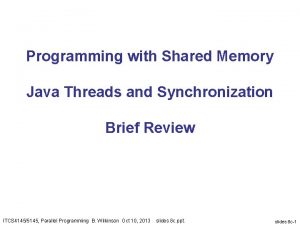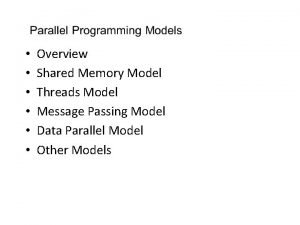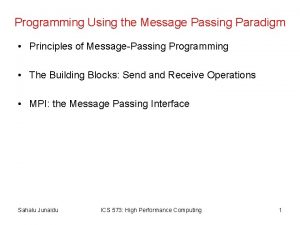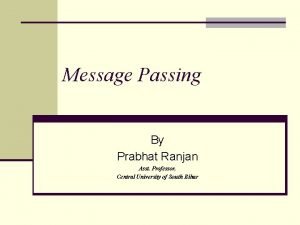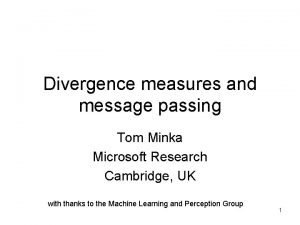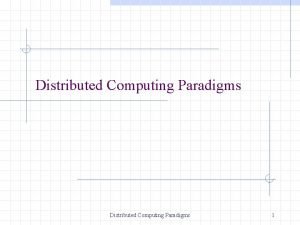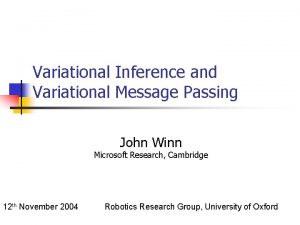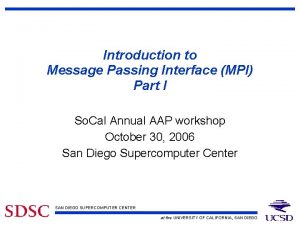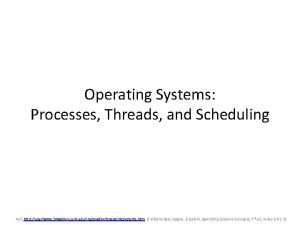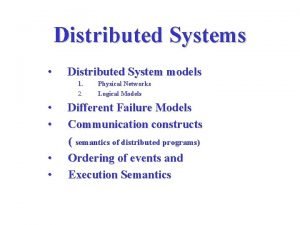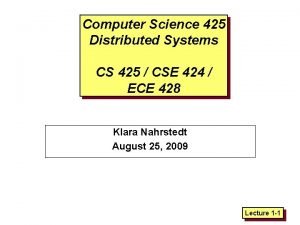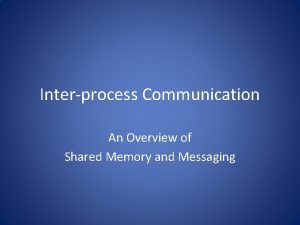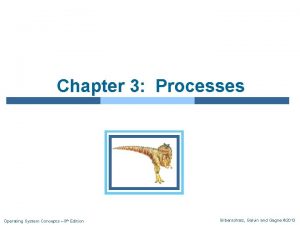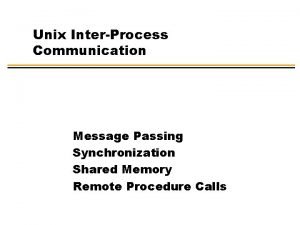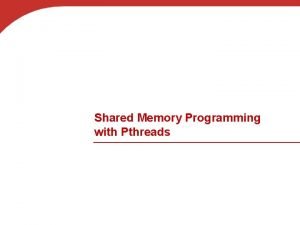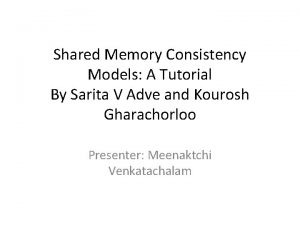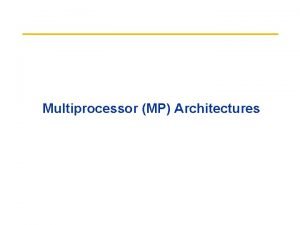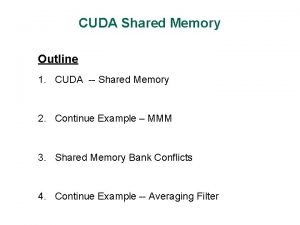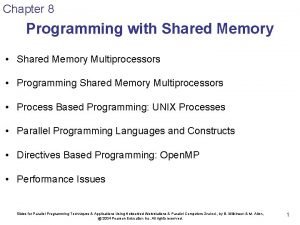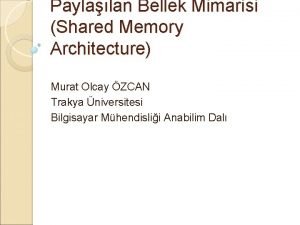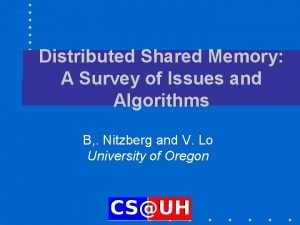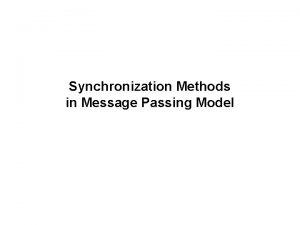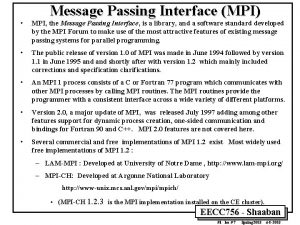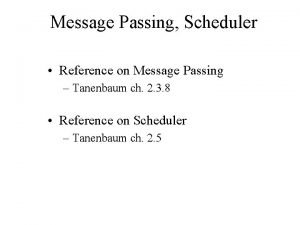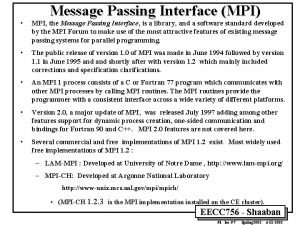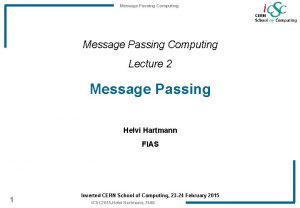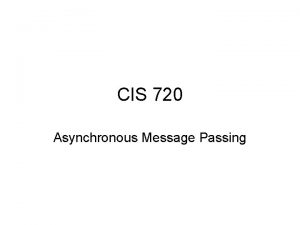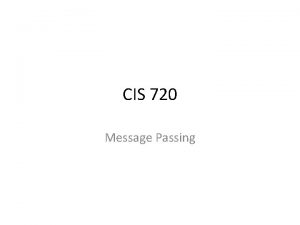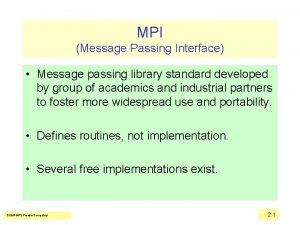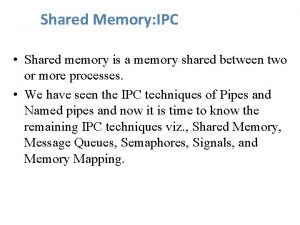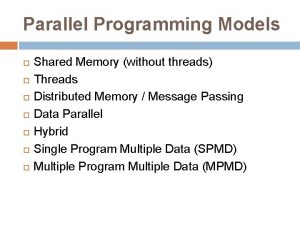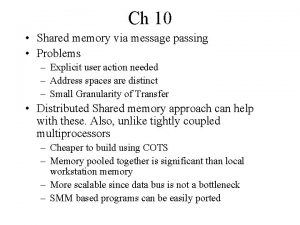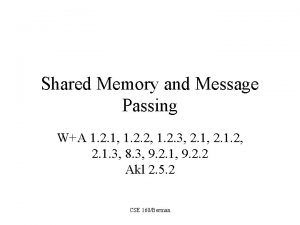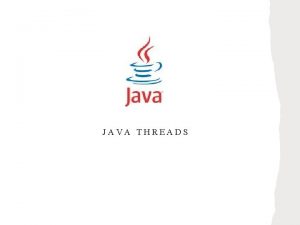Overview Shared Memory Model Threads Model Message Passing





























- Slides: 29

• • • Overview Shared Memory Model Threads Model Message Passing Model Data Parallel Model Other Models

Overview • There are several parallel programming models in common use: – Shared Memory – Threads – Message Passing – Data Parallel – Hybrid • Parallel programming models exist as an abstraction above hardware and memory architectures.

Overview • Although it might not seem apparent, these models are NOT specific to a particular type of machine or memory architecture. In fact, any of these models can (theoretically) be implemented on any underlying hardware. • Shared memory model on a distributed memory machine: Kendall Square Research (KSR) ALLCACHE approach. – Machine memory was physically distributed, but appeared to the user as a single shared memory (global address space). Generically, this approach is referred to as "virtual shared memory". – Note: although KSR is no longer in business, there is no reason to suggest that a similar implementation will not be made available by another vendor in the future. – Message passing model on a shared memory machine: MPI on SGI Origin. • The SGI Origin employed the CC-NUMA type of shared memory architecture, where every task has direct access to global memory. However, the ability to send and receive messages with MPI, as is commonly done over a network of distributed memory machines, is not only implemented but is very commonly used.

Overview • Which model to use is often a combination of what is available and personal choice. There is no "best" model, although there certainly are better implementations of some models over others. • The following sections describe each of the models mentioned above, and also discuss some of their actual implementations.

Shared Memory Model • In the shared-memory programming model, tasks share a common address space, which they read and write asynchronously. • Various mechanisms such as locks / semaphores may be used to control access to the shared memory. • An advantage of this model from the programmer's point of view is that the notion of data "ownership" is lacking, so there is no need to specify explicitly the communication of data between tasks. Program development can often be simplified. • An important disadvantage in terms of performance is that it becomes more difficult to understand manage data locality.

Shared Memory Model: Implementations • On shared memory platforms, the native compilers translate user program variables into actual memory addresses, which are global. • No common distributed memory platform implementations currently exist. However, as mentioned previously in the Overview section, the KSR ALLCACHE approach provided a shared memory view of data even though the physical memory of the machine was distributed.

Threads Model • In the threads model of parallel programming, a single process can have multiple, concurrent execution paths. • Perhaps the most simple analogy that can be used to describe threads is the concept of a single program that includes a number of subroutines: – The main program a. out is scheduled to run by the native operating system. a. out loads and acquires all of the necessary system and user resources to run. – a. out performs some serial work, and then creates a number of tasks (threads) that can be scheduled and run by the operating system concurrently. – Each thread has local data, but also, shares the entire resources of a. out. This saves the overhead associated with replicating a program's resources for each thread. Each thread also benefits from a global memory view because it shares the memory space of a. out.

A thread's work may best be described as a subroutine within the main program. Any thread can execute any subroutine at the same time as other threads. – Threads communicate with each other through global memory (updating address locations). This requires synchronization constructs to insure that more than one thread is not updating the same global address at any time. – Threads can come and go, but a. out remains present to provide the necessary shared resources until the application has completed. – < Threads are commonly associated with shared memory architectures and operating systems.

• Threads Model Implementations From a programming perspective, threads implementations commonly comprise: – A library of subroutines that are called from within parallel source code – A set of compiler directives imbedded in either serial or parallel source code • In both cases, the programmer is responsible for determining all parallelism. • Threaded implementations are not new in computing. Historically, hardware vendors have implemented their own proprietary versions of threads. These implementations differed substantially from each other making it difficult for programmers to develop portable threaded applications. • Unrelated standardization efforts have resulted in two very different implementations of threads: POSIX Threads and Open. MP. • POSIX Threads Library based; requires parallel coding Specified by the IEEE POSIX 1003. 1 c standard (1995). C Language only Commonly referred to as Pthreads. Most hardware vendors now offer Pthreads in addition to their proprietary threads implementations. – Very explicit parallelism; requires significant programmer attention to detail. – – –


Threads Model: Open. MP • Open. MP – Compiler directive based; can use serial code – Jointly defined and endorsed by a group of major computer hardware and software vendors. The Open. MP Fortran API was released October 28, 1997. The C/C++ API was released in late 1998. – Portable / multi-platform, including Unix and Windows NT platforms – Available in C/C++ and Fortran implementations – Can be very easy and simple to use - provides for "incremental parallelism" • Microsoft has its own implementation for threads, which is not related to the UNIX POSIX standard or Open. MP.

Message Passing Model • The message passing model demonstrates the following characteristics: – A set of tasks that use their own local memory during computation. Multiple tasks can reside on the same physical machine as well across an arbitrary number of machines. – Tasks exchange data through communications by sending and receiving messages. – Data transfer usually requires cooperative operations to be performed by each process. For example, a send operation must have a matching receive operation.

Message Passing Model Implementations: MPI • From a programming perspective, message passing implementations commonly comprise a library of subroutines that are imbedded in source code. The programmer is responsible for determining all parallelism. • Historically, a variety of message passing libraries have been available since the 1980 s. These implementations differed substantially from each other making it difficult for programmers to develop portable applications. • In 1992, the MPI Forum was formed with the primary goal of establishing a standard interface for message passing implementations. • Part 1 of the Message Passing Interface (MPI) was released in 1994. Part 2 (MPI-2) was released in 1996. Both MPI specifications are available on the web at www. mcs. anl. gov/Projects/mpi/standard. html.

Parallel Programming Models: Message Passing Model

• Message Passing Model Implementations: MPIstandard for MPI is now the "de facto" industry message passing, replacing virtually all other message passing implementations used for production work. Most, if not all of the popular parallel computing platforms offer at least one implementation of MPI. A few offer a full implementation of MPI-2. • For shared memory architectures, MPI implementations usually don't use a network for task communications. Instead, they use shared memory (memory copies) for performance reasons.

Data Parallel Model • The data parallel model demonstrates the following characteristics: – Most of the parallel work focuses on performing operations on a data set. The data set is typically organized into a common structure, such as an array or cube. – A set of tasks work collectively on the same data structure, however, each task works on a different partition of the same data structure. – Tasks perform the same operation on their partition of work, for example, "add 4 to every array element". • On shared memory architectures, all tasks may have access to the data structure through global memory. On distributed memory architectures the data structure is split up and resides as "chunks" in the local memory of each task.

Parallel Programming Models: Data Parallel Model

Data Parallel Model Implementations • Programming with the data parallel model is usually accomplished by writing a program with data parallel constructs. The constructs can be calls to a data parallel subroutine library or, compiler directives recognized by a data parallel compiler. • Fortran 90 and 95 (F 90, F 95): ISO/ANSI standard extensions to Fortran 77. – Contains everything that is in Fortran 77 – New source code format; additions to character set – Additions to program structure and commands – Variable additions - methods and arguments – Pointers and dynamic memory allocation added – Array processing (arrays treated as objects) added – Recursive and new intrinsic functions added – Many other new features • Implementations are available for most common parallel platforms.

Data Parallel Model Implementations • High Performance Fortran (HPF): Extensions to Fortran 90 to support data parallel programming. – – – Contains everything in Fortran 90 Directives to tell compiler how to distribute data added Assertions that can improve optimization of generated code added Data parallel constructs added (now part of Fortran 95) Implementations are available for most common parallel platforms. • Compiler Directives: Allow the programmer to specify the distribution and alignment of data. Fortran implementations are available for most common parallel platforms. • Distributed memory implementations of this model usually have the compiler convert the program into standard code with calls to a message passing library (MPI usually) to distribute the data to all the processes. All message passing is done invisibly to the programmer.

Other Models programming models besides • Other parallel those previously mentioned certainly exist, and will continue to evolve along with the ever changing world of computer hardware and software. • Only three of the more common ones are mentioned here. – Hybrid – Single Program Multiple Data – Multiple Program Multiple Data

Hybryd • In this model, any two or more parallel programming models are combined. • Currently, a common example of a hybrid model is the combination of the message passing model (MPI) with either the threads model (POSIX threads) or the shared memory model (Open. MP). This hybrid model lends itself well to the increasingly common hardware environment of networked SMP machines. • Another common example of a hybrid model is combining data parallel with message passing. As mentioned in the data parallel model section previously, data parallel implementations (F 90, HPF) on distributed memory architectures actually use message passing to transmit data between tasks, transparently to the programmer.

Single Program Multiple Data (SPMD) • Single Program Multiple Data (SPMD): • SPMD is actually a "high level" programming model that can be built upon any combination of the previously mentioned parallel programming models. • A single program is executed by all tasks simultaneously. • At any moment in time, tasks can be executing the same or different instructions within the same program. • SPMD programs usually have the necessary logic programmed into them to allow different tasks to branch or conditionally execute only those parts of the program they are designed to execute. That is, tasks do not necessarily have to execute the entire program - perhaps only a portion of it. • All tasks may use different data

Multiple Program Multiple Data (MPMD): • • Like SPMD, MPMD is actually a "high level" programming model that can be built upon any combination of the previously mentioned parallel programming models. • MPMD applications typically have multiple executable object files (programs). While the application is being run in parallel, each task can be executing the same or different program as other tasks. • All tasks may use different data

Designing Parallel Programs q Patitioning • Domain Decomposition • Functional Decomposition q Communication q Synchronization Synchronous communications are often referred to as blocking communications since other work must wait until the communications have completed. < Asynchronous communications allow tasks to transfer data independently from one another. < Types of Synchronization: �Barrier �Lock / semaphore �Synchronous communication operations

Partition : Domain Decomposition < Each task handles a portion of the data set.

Partition Functional Decomposition < Each task performs a function of the overall work

Example: Array Processing • Serial Solution – Perform a function on a 2 D array. – Single processor iterates through each element in the array • Possible Parallel Solution – Assign each processor a partition of the array. – Each process iterates through its own partition.

Laws of caution. . . l Speed of computers is proportional to the square of their cost. i. e. cost = Speed C (speed = cost 2) S l Speedup by a parallel computer increases as the logarithm of the number of processors. l Speedup = log 2(no. of processors) S P 2 g o l P

Our Road Map Processor Memory Hierarchy I/O Subsystem Parallel Systems Networking
 Shared memory java
Shared memory java Symmetric shared memory architecture
Symmetric shared memory architecture Message passing model
Message passing model Principles of message passing programming
Principles of message passing programming Features of message passing system
Features of message passing system Divergence measures and message passing
Divergence measures and message passing Is a paradigm of distributed computing to provide
Is a paradigm of distributed computing to provide Message passing
Message passing Distributed operating system ppt
Distributed operating system ppt Variational message passing
Variational message passing Message passing interface tutorial
Message passing interface tutorial Quick passing game
Quick passing game Message passing system in distributed system
Message passing system in distributed system System models in distributed systems
System models in distributed systems Message passing system in distributed system
Message passing system in distributed system Functional message
Functional message Message passing os
Message passing os Message passing interface
Message passing interface Message passing os
Message passing os Shared memory in unix
Shared memory in unix Shared memory programming
Shared memory programming Shared memory consistency models a tutorial
Shared memory consistency models a tutorial Share a single centralized memory
Share a single centralized memory Symmetric shared memory architecture
Symmetric shared memory architecture Shared memory bank conflicts
Shared memory bank conflicts Symmetric shared memory architecture
Symmetric shared memory architecture Distributed shared memory
Distributed shared memory Symmetric shared memory architecture
Symmetric shared memory architecture Murat olcay
Murat olcay Design issues of distributed shared memory
Design issues of distributed shared memory
